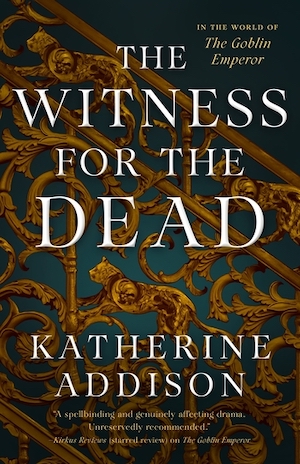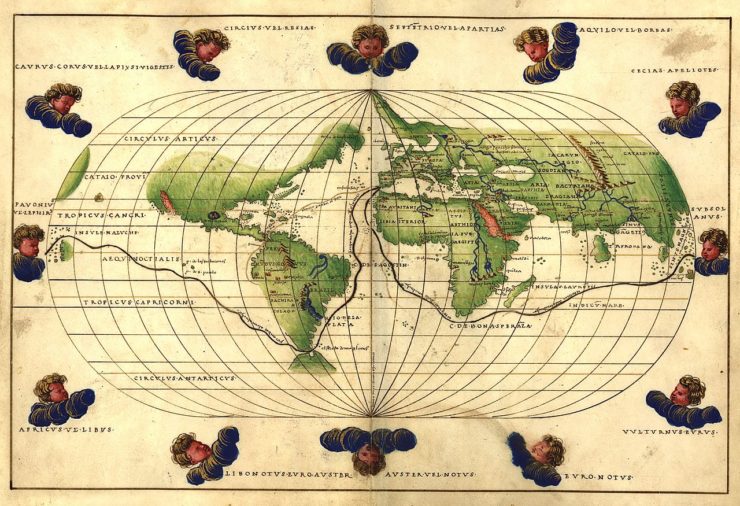The goal of building a fictional world isn’t to build a world. It’s to build a metaphor. And the success of the world you build isn’t measured by how complete or coherent or well-mapped the world is. It’s measured by whether the world and the meaning map onto each other.
Arguments about worldbuilding in SFF don’t generally focus on metaphors. Instead they often focus, somewhat paradoxically, on realism. How can you best make a world that feels as detailed and rich and coherent as the world you’re living in now, complete with impeachment trials, global warming, pandemics, pit bulls, and K-pop? Should you, in the manner of Tolkien, systematically construct every detail of your fantasy realm, with maps and histories and even complete languages? Or should you leave spaces to suggest vast uncharted bits? Maybe sometimes it’s more evocative not to tell your readers what lives on every part of the map, or what the Elvish means. As China Mieville says, “A world is going to be compelling at least as much by what it doesn’t say as what it does. Nothing is more drably undermining of the awe at hugeness that living in a world should provoke than the dutiful ticking off of features on a map.”
But sometimes left out of these discussions is the idea that authors aren’t always trying to create worlds that feel real, or complete, or even particularly huge. To map or not to map isn’t just a question of finding the best cartographic technique to arrive at the same mound of Mordor. The discussion of which way to get where can leave out the many possible Wheres in fiction—and that the journey and the destination are often tied together like the braided colons of the purple space critters of Br’leyeh. Which is very tied together indeed.
Again—and unlike the whimsical purple colons of Br’layah—Tolkien’s Middle-earth is famous for its careful construction. That’s part of the fun of the book. The sense of the combined weight of mystery and history and language all carefully and lovingly delineated isn’t there because Tolkien abstractly believed that all fantasy worlds should start with linguistics. Rather, Tolkien creates a complete world because he is writing about the threat of civilizational collapse. He builds his world up because he wants his readers to be invested in the detail and the craft, so that they feel a sense of loss and fear when all that detail and craft is threatened. Faced with two world wars and an existential threat to the rich history he loved, Tolkien poured his love of a passing era into the creation of his own rich history. Middle-earth holds together so well precisely because it is a reaction, and a response, to a real world which seemed to be coming apart.
Buy the Book


The Witness for the Dead
Tolkien’s worldbuilding is essentially inspired by nostalgia. It’s fitting that he’s had so many imitators, who draw new maps to return to versions of Middle-earth, just as Tolkien drew his maps of Middle-earth as a way of returning to an England that seemed to be slipping away.
Still, there are plenty of interesting epic fantasy variations and explorations that aren’t bent on re-memorializing the Shire. Jacqueline Carey’s Kushiel’s Dart (2001), for example, is an intricately detailed alternate Europe in which Christianity never gained a foothold as a cultural force. Free of repressive attitudes and doctrines surrounding sex, Carey’s world is one of sensual pleasure and sophistication, though increasingly threatened by callous northern barbarians. Like Tolkien’s world, hers is a monument of completeness. But she switches Tolkien’s terms, so that readers end up fearing the loss of an urbane sophisticated cosmopolis, rather than a sturdy rural England. It’s epic fantasy for Remainers.
Carey and Tolkien show that sweepingly meticulous worldbuilding can sustain different metaphors and meanings in its towers and boudoirs. But sometimes what an author has to say isn’t meticulous, but vague or confusing. Philip K. Dick, for one, is an author who famously wrote about how reality didn’t make any sense by creating worlds that didn’t fit together. His novels and stories are often train wrecks of worldbuilding (or even world wrecks of train building).
In Do Androids Dream of Electric Sheep (1968), for example, Dick imagines a future world in which human-like androids have been developed to do menial tasks. The hero, Deckard, is a bounty hunter employed to retire (i.e., kill) androids when they go rogue. Deckard works closely with the police. But at one point in the book, he is captured by a policeman he doesn’t know, and taken to a completely different fully staffed police station. Deckard lays out the illogic himself:
It makes no sense…. Who are these people? If this place has always existed, why didn’t we know about it? And why don’t they know about us? Two parallel police agencies, he said to himself; ours and this one. But never coming in contact—as far as I know—until now. Or maybe they have, he thought. Maybe this isn’t the first time. Hard to believe, he thought, that this wouldn’t have happened long ago. If this really is a police apparatus here; if it’s what it asserts itself to be.
The book suggests that either all the police are fake androids, or that Deckard himself is an android—explanations which don’t really answer any of the questions Deckard lays out above.
Thematically, though, the fake police station makes perfect (non)sense. Do Androids Dream Of Electric Sheep? is a novel about how the boundaries of who is and isn’t considered human, or part of the community, are essentially arbitrary. It questions the policing of deviance. And how better to do that than to create a world in which the police themselves are an ersatz anomaly? We never learn really what the police station is or why it’s there any more than we ever learn why Gregor Samsa wakes up as a giant insect. The worldbuilding is off, broken, and incomprehensible because the world itself is off, broken, and incomprehensible.
Colson Whitehead’s 2016 novel Underground Railroad is even more explicit in its refusal to cohere. Initially, the novel seems to be in the tradition of antebellum slave narratives. That’s a genre that was devoted to realism, or to what might be called the worldbuilding of verisimilitude. Slave narratives were political documents, intended to convince the public of the truth of the suffering of enslaved people and to inspire them to action for change. Solomon Northup’s memoir Twelve Years a Slave (1853), to cite one example, includes lengthy discussions about the details of cotton farming. To readers now, these details may seem tedious and unnecessary. But at the time they no doubt were meant to demonstrate that Northup really had been held in bondage on a plantation, and that his account was true.
Contemporary depictions of slavery, like the movie 12 Years a Slave, often adopt a similar realist approach. Whitehead, though, does something different. Underground Railroad opens with the protagonist Cora in bondage in Georgia before the Civil War. But when she escapes, the world starts to fracture. She travels to South Carolina, where there is no slavery. Instead, whites sterilize Blacks and spout eugenic ideology that didn’t become popular until the late 19th and early 20th century. In Indiana, whites launch violent attacks on Black communities, as they did in the post-Reconstruction era. Whitehead’s North Carolina has instituted a regime of extermination similar to the Nazis; Cora has to hide out like Anne Frank and other Jewish people hidden by non-Jewish resistors. The spatial map of the United States is turned into a temporal map of injustice. All of history is compressed into a nightmare landscape that is as nonsensical and inescapable as American racism itself.
The point again isn’t that coherent worldbuilding is right or wrong. The point is that the coherence of fiction is part of what that fiction says to the reader. Walter Tevis’ The Hustler (1959) puts you in pool halls grimy and solid enough that you can feel the cue chalk under your fingernail because it’s a story about a guy facing the ugly truths of existence. Joanna Russ’ The Female Man (1975) creates several only partially realized alternate worlds as a way of suggesting the tentative, contingent nature of opposition to patriarchy—and the tentative, contingent nature of patriarchy itself. Terry Pratchett’s Discworld is a flat disc carried on the back of a bunch of turtles, and if you have ever read Terry Pratchett you know why those turtles are at home in his prose.
Some writers imagine carefully crafted realms. Some imagine realms with holes in them, realms that defy logic or seem impossible. But whatever universe you have in your head, there is no place divorced from the meaning of that place. What we say about the world can’t be teased apart from what the world is—we can’t imagine a world without meaning. We live in a land called metaphor. Even its cartography is a symbol.
Thanks to Jeannette Ng, who helped me think through some of these ideas on Twitter.
Noah Berlatsky is the author of Wonder Woman: Bondage and Feminism in the Marston/Peter Comics (Rutgers University Press).










